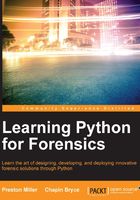
Classes and object-oriented programming
Python supports object-oriented programming (OOP) using the built-in class keyword. OOP allows advanced programming techniques and sustainable code that supports better software development. Because OOP is not commonly used in scripting and is above the introductory level, this book will implement OOP and some of its features in later chapters after we master the basic features of Python. Everything in Python, including classes, functions, and variable, are objects. Classes are useful in a variety of situations, allowing us to design our own objects to interact with data in a custom manner.
Let's look at the datetime module for an example of how we will interact with classes and their methods. This library will be used frequently throughout the book as it is essential for interpreting and manipulating timestamps. This library contains several classes, such as datetime, timedelta, and tzinfo. Each of these classes handles a different functionality associated with timestamps. The most commonly used is the datetime class, which can be confusing as it is a member of the datetime module. This class is the simplest and is used to represent dates as Python objects. The two other mentioned classes support the datetime class by allowing dates to be added or subtracted through the timedelta class, and timezones represented through the tzinfo class.
Focusing on the datetime.datetime class, we will look at how we can use this object to create multiple instances of dates and extract data from them. To begin, as seen in the following code block, we must import this library to access the classes and methods. Next, we pass arguments to the datetime class and assign the datetime object to date_1. Our date_1 variable contains the value to represent April Fools Day, 2016. Since we did not specify a time value when initiating the class, the value will reflect midnight, down to the millisecond. As we can see, like functions, classes too can have arguments. Additionally, a class can contain its own functions, commonly called methods. An example of a method is the call to now(), allowing us to gather the current timestamp for our local machine and store the value as date_2. These methods allow us to manipulate data specific to the defined instance of the class. We can see the contents of our two date objects by printing them in the interactive prompt:
>>> import datetime >>> date_1 = datetime.datetime(2016,04,01) >>> date_2 = datetime.datetime.now() >>> print date_1, " | ", date_2 2016-04-01 00:00:00.000 | 2016-04-01 15:56:10.012915
We can assess properties of our date objects by calling specific class attributes. These attributes are usually leveraged by code within the class to process the data. We can also use these attributes to our advantage. For example, the hour or year attributes allow us to extract the hour or the year from our date objects. Though this may seem simple, it becomes more helpful in other modules when accessing the parsed or extracted data from the class instance:
>>> date_2.hour 15 >>> date_1.year 2016
As mentioned before, we can always run the dir() and help() functions to provide context on what methods and attributes are available for a given object. If we run the following code, we can see that we can extract the weekday or format the date following the ISO format. These methods provide additional information about our datetime objects and allow us to take full advantage of what the class object has to offer:
>>> dir(date_1) ['__add__', '__class__', '__delattr__', '__doc__', '__eq__', '__format__', '__ge__', '__getattribute__', '__gt__', '__hash__', '__init__', '__le__', '__lt__', '__ne__', '__new__', '__radd__', '__reduce__', '__reduce_ex__', '__repr__', '__rsub__', '__setattr__', '__sizeof__', '__str__', '__sub__', '__subclasshook__', 'astimezone', 'combine', 'ctime', 'date', 'day', 'dst', 'fromordinal', 'fromtimestamp', 'hour', 'isocalendar', 'isoformat', 'isoweekday', 'max', 'microsecond', 'min', 'minute', 'month', 'now', 'replace', 'resolution', 'second', 'strftime', 'strptime', 'time', 'timetuple', 'timetz', 'today', 'toordinal', 'tzinfo', 'tzname', 'utcfromtimestamp', 'utcnow', 'utcoffset', 'utctimetuple', 'weekday', 'year'] >>> date_1.weekday() 4 >>> date_2.isoformat() 2016-04-01T15:56:10.012915